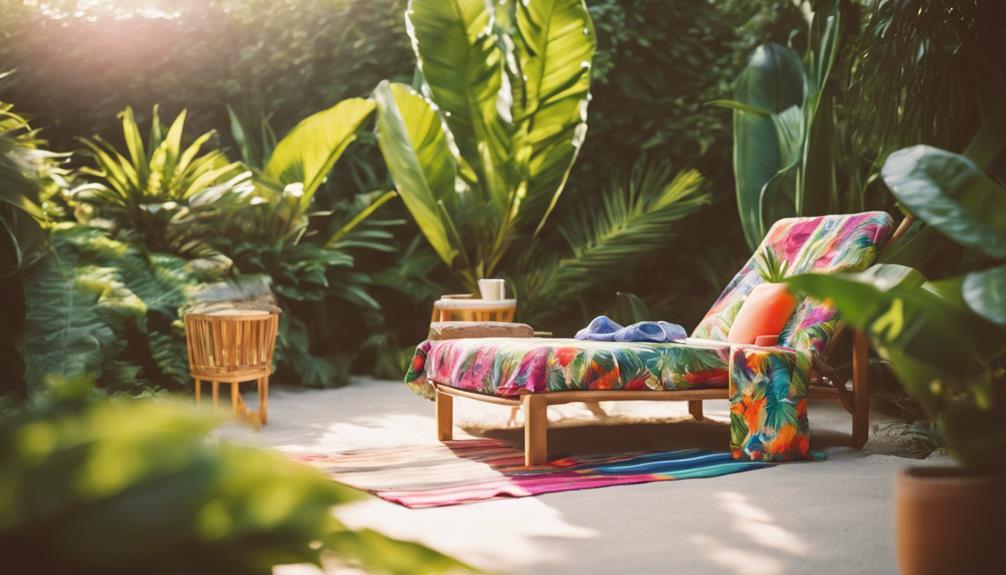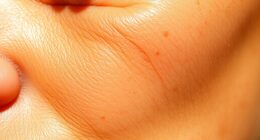Keeping your tanning bed fresh and eco-friendly is easier than it sounds! Start with a natural disinfectant by mixing equal parts vinegar and water—just spray, let it sit for a bit, and wipe it down. You can also use reusable spray bottles and bamboo cleaning tools to cut down on waste. Make it a habit to clean the bed after each use to keep bacteria at bay. And don't forget to use microfiber cloths; they're gentle and won't scratch. With these tips, you'll keep both your tanning bed and the planet happy, and there's even more fun stuff ahead!
Key Takeaways
- Use biodegradable cleaners designed for tanning beds to ensure effective sanitation while protecting the environment.
- Create a natural disinfectant by mixing equal parts distilled white vinegar and water for a safe cleaning solution.
- Utilize reusable spray bottles and bamboo cleaning tools to minimize waste and support sustainability in your cleaning routine.
- Regularly clean tanning beds after each use to eliminate bacteria, scheduling deep cleans weekly for optimal hygiene.
Eco-Friendly Cleaners
When maintaining your tanning beds, choosing eco-friendly cleaners not only protects the environment but also guarantees a safe space for your clients.
Instead of using harsh chemicals that could make you feel like a mad scientist, grab biodegradable cleaners designed specifically for tanning beds. You'll be amazed at how well natural alternatives like vinegar and water can work!
Just let the cleaner sit for a bit to tackle those sneaky germs. Plus, using specially formulated disinfectants helps keep your tanning beds sparkling clean while being gentle on the planet.
Natural Disinfectants

Natural disinfectants, like a blend of distilled white vinegar and essential oils, offer an effective and eco-friendly solution for keeping your tanning beds clean and germ-free.
You can easily whip up a homemade cleaner by mixing equal parts vinegar and water; just shake it up before you spray! This mixture not only fights off germs but also leaves your tanning bed smelling fresh.
Spray it evenly on the surfaces, let it sit for a few minutes, and then wipe it down. Trust me, your tanning bed will thank you!
Plus, it's way better for the planet than harsh chemicals. So, go ahead, give those natural disinfectants a try, and keep your tanning space sparkling clean without the guilt!
Sustainable Cleaning Accessories

Choosing sustainable cleaning accessories can enhance your eco-friendly tanning bed maintenance while reducing waste. Instead of single-use items, go for reusable spray bottles—your future self will thank you!
Look for applicators made from recycled materials; they're like superheroes for the environment. Bamboo cleaning tools are also a fantastic choice, as they're both effective and sustainable.
Plus, using these eco-friendly accessories is a win-win! You'll keep your tanning bed sparkling clean and show Mother Nature some love. Just imagine how great it feels to clean while being kind to the planet!
Regular Maintenance Practices

Regular maintenance of tanning beds is essential for ensuring a hygienic and safe tanning experience for everyone. You don't want to tan in a place that hasn't been properly cleaned!
Here are some quick tips to keep your tanning bed fresh and sparkling:
- Clean the bed after each use to kick bacteria to the curb.
- Don't forget to wipe down the acrylic casing, fan, and bulbs.
- Let your cleaner sit for a minute before wiping it off for maximum germ-fighting power.
- Schedule deep cleanings every week to keep everything in top shape.
Non-Abrasive Cleaning Materials

Maintaining a hygienic tanning bed goes hand in hand with using non-abrasive cleaning materials to protect its surfaces while effectively removing dirt and bacteria. You want to keep your tanning bed looking great without risking scratches or damage, right? Microfiber cloths and soft sponges are your best pals for this task!
Here's a quick guide to help you choose the right materials:
| Material | Benefits | Caution |
|---|---|---|
| Microfiber Cloth | Lint-free, gentle on surfaces | Wash regularly |
| Soft Sponge | Effective dirt removal | Avoid harsh scrubbing |
| Eco-Friendly Cleaner | Gentle yet powerful | Test on a small area |
Safe Tanning Bed Usage

Following manufacturer guidelines is essential for ensuring safe and effective tanning bed usage. You want to enjoy your tanning experience while keeping your skin healthy, right?
Here are some tips to keep in mind:
- Limit your session to 15-20 minutes, especially if you're a beginner.
- Always wear protective eyewear; your peepers deserve a break!
- Hydrate before and after tanning to keep your skin happy.
- Check your skin regularly for any unusual changes—better safe than sorry!
Effective Tanning Bed Lotions

Choosing the right tanning bed lotion can greatly enhance your tanning experience and help you achieve a deeper, longer-lasting glow. You'll want to look for lotions packed with moisturizing ingredients like aloe vera and antioxidants, which keep your skin hydrated and healthy. Here's a quick guide to some effective options:
| Lotion Type | Key Ingredients | Average Price |
|---|---|---|
| Intensifier | DHA, Aloe Vera | $10 – $30 |
| Bronzers | Natural Oils, Caramel | $15 – $40 |
| Self-Tanners | DHA, Erythrulose | $20 – $50 |
Alternatives to Tanning Beds

Exploring alternatives to tanning beds can help you achieve a radiant glow without the risks associated with UV exposure. You don't have to sacrifice your skin's health for that sun-kissed look! Here are some fun options to evaluate:
- Self-Tanners: They're easy to apply and come in various forms, like lotions or sprays.
- Bronzers: These give an instant glow and wash off easily when you want a break.
- Spray Tans: Get a professional spray tan for a flawless finish!
- Tanning Towelettes: Perfect for on-the-go, just wipe and glow!
Frequently Asked Questions
Can Eco-Friendly Cleaners Be Used on All Tanning Bed Surfaces?
Yes, you can use eco-friendly cleaners on most tanning bed surfaces. Just make sure they're compatible with the materials, and avoid harsh chemicals. Always check product guidelines to maintain the integrity of your tanning equipment.
How Often Should I Replace My Reusable Cleaning Accessories?
Regularly replace your reusable cleaning accessories to maintain maximum cleanliness. Ideally, swap them out every three to six months. Keeping your tools fresh guarantees effective sanitation, so your space stays spotless and safe for everyone.
Are Homemade Cleaners as Effective as Commercial Products?
Homemade cleaners can be just as effective as commercial products if you use the right ingredients. By mixing vinegar and water or essential oils, you'll achieve cleanliness without harsh chemicals, benefiting both your health and the environment.
What Are the Benefits of Using Bamboo Cleaning Tools?
Imagine a forest whispering secrets of sustainability. Using bamboo cleaning tools not only protects our planet but also offers strength and softness, ensuring you maintain cleanliness while embracing eco-friendly practices that resonate with nature's essence.
Can I Mix Different Eco-Friendly Cleaners for Better Results?
You shouldn't mix different eco-friendly cleaners, as they can react unpredictably, reducing effectiveness. Stick to one cleaner at a time for ideal results. This way, you guarantee a safe and efficient cleaning process every time.
How Can I Keep Tanning Beds Clean in an Eco-Friendly Manner?
When it comes to ecofriendly tanning bed sanitation, there are a few simple steps you can take to keep your tanning beds clean in an environmentally friendly manner. Use natural, biodegradable cleaning products, regularly wipe down surfaces with eco-friendly disinfectant wipes, and encourage clients to use a towel while tanning.
Conclusion
So, there you have it! By choosing eco-friendly cleaners and sustainable tools, you're not just keeping your tanning bed spotless—you're also doing your part to save the planet.
Imagine a world where your skin glows, and Mother Nature smiles right back at you!
With a little routine and these tips in your back pocket, you can enjoy every tanning session guilt-free.
Ready to jump in and make a splash with your new cleaning habits? Let's get started!









